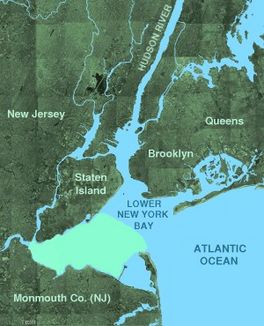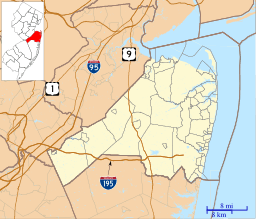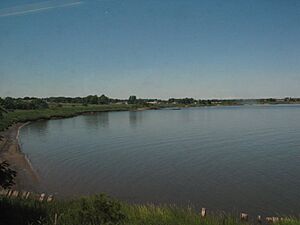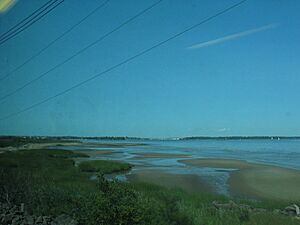Raritan Bay facts for kids
Quick facts for kids Raritan Bay |
|
|---|---|

Raritan Bay is shown as highlighted area south of Lower New York Bay and north of Monmouth County.
|
|
| Coordinates | 40°29′00″N 74°10′59″W / 40.48333°N 74.18306°W |
| Type | Bay |
| Etymology | Raritan Indian tribe |
| Part of | New York Bight |
| Primary inflows | Primary:
Secondary:
|
| Ocean/sea sources | Atlantic Ocean |
| Basin countries | United States |
| Managing agency |
|
| Max. length | 9 miles (14 km) |
| Max. width | 12 miles (19 km) |
| Surface area | 69,188 acres (27,999 ha) |
| Average depth | 11–30 feet (3.4–9.1 m) |
| Max. depth | 20 feet (6.1 m) |
| Residence time | 60 tidal cycles |
| Salinity | 12-32 ppt |
| Shore length1 | 33,500 acres (13,600 ha) |
| Surface elevation | 0 m (0 ft) |
| Frozen | Coastal or inner bays |
| Benches |
|
| Settlements | New Jersey
New York |
| 1 Shore length is not a well-defined measure. | |
Raritan Bay is a large bay located where the Raritan River meets the Atlantic Ocean. It sits between the states of New York and New Jersey. This bay is part of the bigger New York Bight, which is a large curve in the coastline.
The bay has Staten Island to its northwest and Perth Amboy, New Jersey to its west. To the south, you'll find towns along the Raritan Bayshore in New Jersey. To the east, it connects with Sandy Hook Bay. The bay gets its name from the Raritan people, a Native American tribe. They were part of the Lenape tribe and lived here for thousands of years before European settlers arrived in the 1600s.
Contents
History of Raritan Bay
People have lived around Raritan Bay for a very long time. Scientists have found proof that humans were here even at the end of the Pleistocene Ice Age. Over time, different groups of people settled here. They learned to live near the water, hunting and gathering shellfish like clams and oysters. Later, they also started farming.
The Lenape tribes, who lived here when the first European settlers came, left behind huge piles of shells. These piles, called shell middens, show how much they used the bay for food. Sadly, early settlers often used these shell piles to build roads or fertilize their farms. For example, the town of Tottenville was once known for its roads paved with oyster shells.
How Raritan Bay Was Formed
Raritan Bay's shape was greatly influenced by ancient glaciers. During the last Ice Age, called the Wisconsin glaciation, a huge ice sheet covered much of North America. The Raritan River was a major waterway that carried melted ice away from the glacier.
Before the Ice Age, the water in this area flowed south towards the Delaware River. But as the glaciers grew and then melted, the Raritan River changed its path. It carved out new channels and captured water from other rivers.
As the glaciers melted, sea levels rose. This process, called the Flandrian Transgression, flooded the deep valleys of the Hudson River, Raritan River, and Arthur Kill, forming the bay we see today. The area around Raritan Bay changed from a cold, treeless tundra to forests of spruce and pine. Eventually, these were replaced by the leafy forests we see now.
About 2,500 years ago, the inner parts of Raritan Bay began to fill with sediment. Large oyster beds started to grow in the rivers that flowed into the bay. The sea level has continued to rise, about one foot every century. This rise has caused the shoreline to move inland, sometimes by as much as two miles, since colonial times.
Economy and Ecology of Raritan Bay
In the 1800s and early 1900s, Raritan Bay was a very important place for fishing and harvesting shellfish. Oysters were especially plentiful, and this industry helped many people live and work around the bay. It also helped feed the many immigrants coming to the area. However, as fishing methods improved, too many resources were taken from the bay. The fishing industry was at its busiest from the late 1880s to the 1910s.
Over time, fishing and farming were replaced by new industries. These included shipbuilding, making ceramics, chemicals, and paint, and refining oil. In areas like Keasbey, New Jersey, large holes were dug to get clay for bricks. Huge piles of chemical waste and landfills were created from these growing industries.
Many things contributed to the bay becoming polluted. Building structures like dikes and seawalls, spraying chemicals to control mosquitoes, draining wetlands, and filling in low-lying areas all had an impact. Also, waste from homes, cars, factories, and even trash dumped in the ocean made the bay unhealthy.
For most of the 1900s, the shores of Arthur Kill had some of the world's largest oil facilities. This led to many oil spills, big and small. Also, the Arthur Kill drains water from the Fresh Kills Landfill, which was once one of the largest landfills on Earth. Water seeping from landfills can carry harmful chemicals into the bay. These chemicals harmed the tiny plants and animals (plankton), shellfish, fish, birds, and other wildlife that depend on the bay.
The pollution caused a major environmental problem. At its worst, the bay became almost lifeless due to pollution and a lack of oxygen caused by too much algae. Since the 1970s, many environmental efforts have helped the bay slowly recover. Sea life is returning, but it's still not as rich as it was in the past. Some fish and bird species are still struggling, and new species introduced from other parts of the world can also cause problems. However, there is hope! Oysters, which had completely disappeared from the Hudson River around World War II, are now starting to grow there again naturally.
Because of past industrial pollution, some fish caught in the bay still have high levels of certain chemicals. This has led to government advice against eating these fish regularly.
A deep channel has been dredged in the bay. This allows large commercial ships to travel into the Arthur Kill.
Aquatic Species of Raritan Bay
Raritan Bay is home to many different kinds of fish and other water creatures. If you go recreational fishing here, you might catch:
- striped bass
- fluke
- winter flounder
- bluefish
- porgy
- black sea bass
- smoothhound shark
- northern puffer
- northern king fish
- oyster toadfish
- tautog
- weakfish
The bay also has many types of crustaceans, including:
- blue crab
- fiddler crab
- green crab
- horseshoe crab
- spider crab
You can also find Clams and mussels living in Raritan Bay. Because it's close to busy areas like Central Jersey and New York City, the bay is a very popular spot for people who enjoy fishing.
Images for kids





